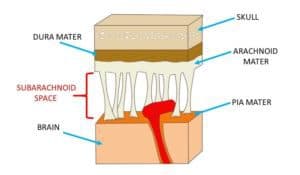Contents:
- Medical Video: Hemorrhagic Stroke (Brain Hemorrhage)
- Get to know subarachnoid bleeding
- Signs and symptoms of subarachnoid bleeding
- What causes subarachnoid bleeding?
- Complications of arachnoid bleeding that may occur
- How to prevent subarachnoid bleeding?
Medical Video: Hemorrhagic Stroke (Brain Hemorrhage)
Severe head trauma that occurs due to motorized accidents or sports injuries that affect the head can cause trauma to the brain. One of the most common types of brain trauma is subarachnoid bleeding. Unfortunately, this condition is often not detected quickly because it generally does not cause significant symptoms. Whereas in 50 percent of cases, subarachnoid bleeding can have fatal consequences. One in eight people who experience it can die before reaching the hospital.
So, it's important to know what the symptoms are so that if this happens to you in the future, you can quickly get medical help.The following is a more complete review of subarachnoid bleeding.
Get to know subarachnoid bleeding
The brain is protected by the membranes of the meninges, which have three layers consisting of pia meters (inside), arachnoid (center), and dura meters (outside).
Subarachnoid hemorrhage is bleeding that occurs in the subarachnoid space, which is the space between two layers of membrane that wrap around the brain. This room is located just below the arachnoid membrane and above the meter pia.

Subarachnoid space is the space for brain fluid gathering called the cerebrospinal. This fluid is responsible as a cushion to protect the brain from injury.
When triggered by burdensome physical activity (sometimes even during sex), physical trauma to the head, or certain medical conditions that cause brain trauma, blood can leak into the subarachnoid space, so that cerebrospinal fluid becomes mixed with blood. This can cause coma, paralysis, physical disability, and even death.
Subarachnoid hemorrhage is the cause of 5-10 percent of stroke events, and about one in four deaths associated with stroke.
Signs and symptoms of subarachnoid bleeding
Usually subarachnoid bleeding appears without symptoms.However, the main symptoms and the most common of these bleeding issudden headaches that felt very severe. The pain might be the same as receiving a hard hit on the head. This headache usually spreads to the back of the head.
In addition, there are several other common symptoms that may arise, including:
- Neck or neck pain
- Shoulder pain
- Sensitive to light (photophobia)
- Blurred or double vision
- Symptoms such as stroke (speaking less clearly and feeling weak on one side of the body)
- Missing consciousness or convulsions
- Numbness throughout the body
- Confusion or feeling dazed (delirium)
- Nausea and vomiting
- Bleeding to the eyeball
- Blood pressure increases
These symptoms appear suddenly, and you may lose consciousness quickly. Get medical attention immediately if you have just experienced head trauma and experience the above symptoms with severe headaches.
What causes subarachnoid bleeding?
Besides severe physical trauma to the head, pthe most common cause of subarachnoid bleeding is a ruptured aneurysm. Aneurysms are swelling of blood vessels caused by a weakened vessel wall. The greater the swelling, the higher the risk of aneurysms can rupture.
The exact cause of aneurysm is not clearly known. However, gender (female),age (40-65 years), people who smoke, consume excessive alcohol, or have high blood pressure (hypertension) have a higher risk of experiencing aneurysms that are at risk of rupture. Other than that,Congenital defects in some people can also cause blood vessels to weaken and thin out, increasing the risk of aneurysms.
Other conditions that can cause subarachnoid bleeding arearterial malformation or abbreviated with AVM. AVM is a group of blood vessels (arteries and veins) that develop abnormally so that they are interconnected with one another. Both of these blood vessels are connected by a fistula, so sometimes it is also called an arteriovenous fistula.
AVM is a common cause of subarachnoid hemorrhage. AVM can occur in blood vessels in the spinal cord, brain stem, or brain. The malformed blood vessels can then form an aneurysm. This condition may arise because of a disturbance when the fetus develops in the womb. Symptoms do not tend to appear until bleeding occurs.
Complications of arachnoid bleeding that may occur
The most common complication is recurrent bleeding. Aneurysms that rupture and have healedby itself it may break again. Repeated bleeding can increase the risk of death. Coma due to subarachnoid bleeding can also cause death.
In addition, other complications that might occur include:
- Brain damage caused by a reduction in blood supply to the brain.
- Epilepsy, where a person experiences recurrent seizures (after treatment).
- Problems with certain mental functions; like memory, planning and concentration.
- Mood changes, such as depression.
- In some cases, you may experience seizures or strokes after treatment.
How to prevent subarachnoid bleeding?
There are a number of things you can do to reduce the risk of arachnoid bleeding, namely:
- Stop smoking and reduce alcohol consumption.
- Prevent high blood pressure by doing regular exercise, carrying out a healthy diet, and losing weight if you are overweight.
- Identify potential problems in the brain, by making early detection.
- Use personal protective devices when at risk of physical activity, for example at work or while exercising. Use a helmet and face shield mask.












